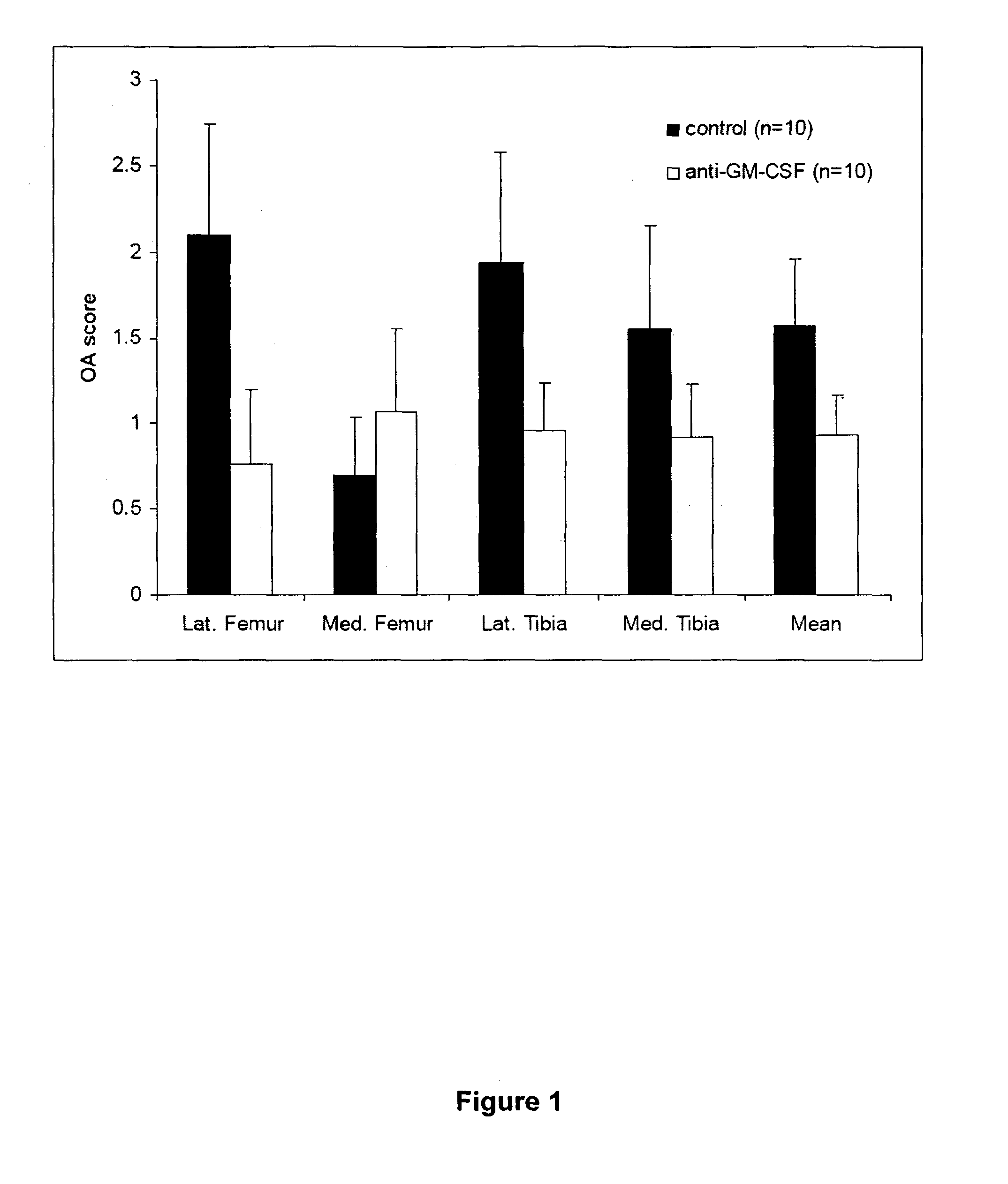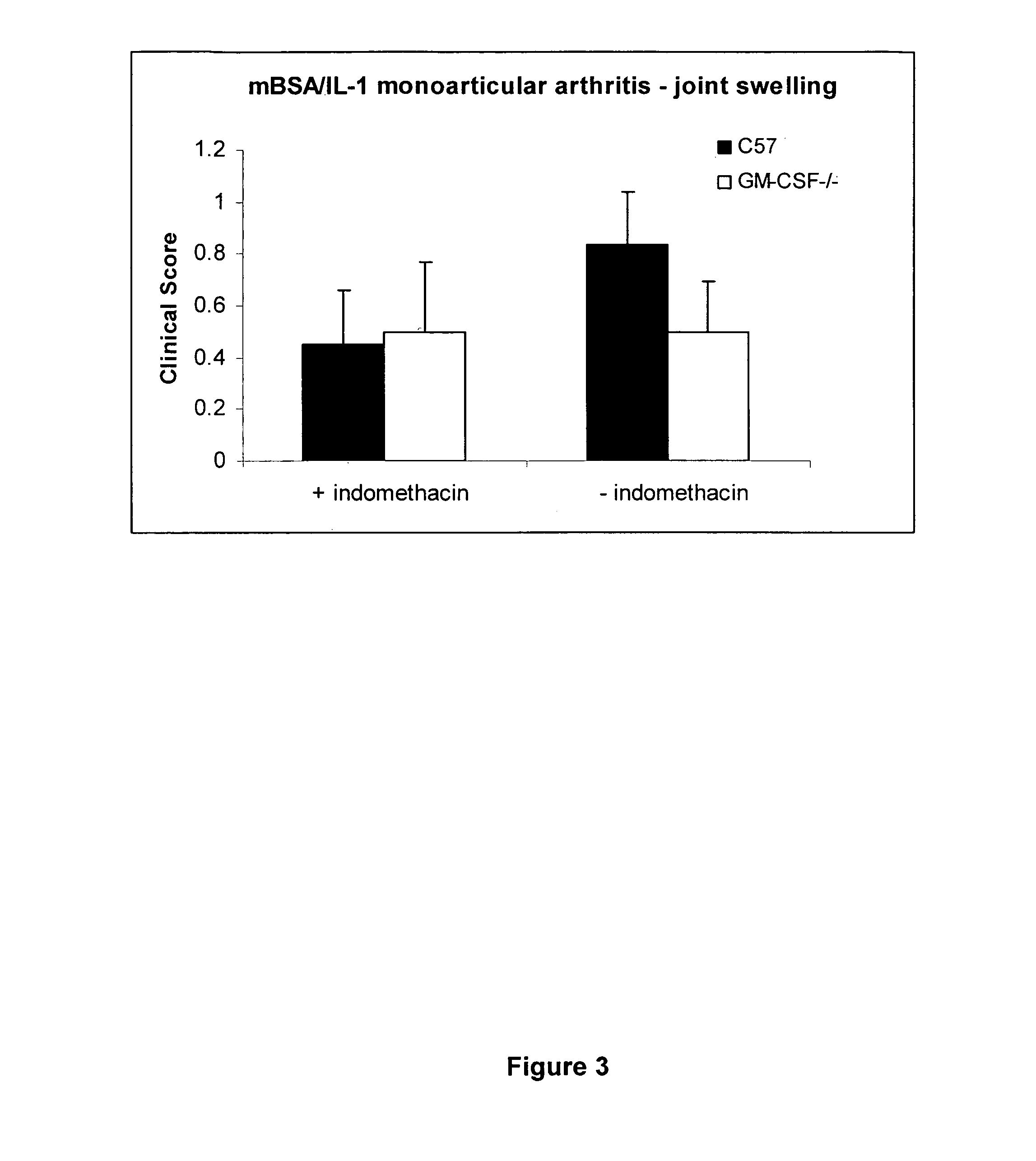Method of treating pain using an antagonist of GM-CSF
a technology of gmcsf and pain, applied in the field of pain treatment and prophylaxis, can solve the problems of not teaching, suggesting or providing rationality, and achieve the effect of significant analgesic effects, increasing the level of vocalization, and increasing the intensity of vocalization
- Summary
- Abstract
- Description
- Claims
- Application Information
AI Technical Summary
Benefits of technology
Problems solved by technology
Method used
Image
Examples
example 1
Generation of a GM-CSF− / − Mouse
[0097]The generation of GM-CSF− / − mice is described in Stanley et al (1994). Proc. Natl. Acad. Sci. USA 91:5592. Briefly, chimeric mice were generated by microinjection of 129 / OLA-derived ES cells (H-2b) with a disrupted GM-CSF gene into C57BL / 6 (H-2b) host blastocysts. Germline transmitters of the mutated GM-CSF allele were crossed with C57BL / 6 mice for 11 generations, giving GM-CSF+ / − mice that were interbred to yield the GM-CSF− / −, GM-CSF+ / −, and GM-CSF+ / + mice used for the experiments. GM-CSF genotype status was determined by PCR analysis of tail DNA. Animals were fed standard rodent chow and water ad libitum and were housed with same sex littermates in sawdust-lined cages. Mice of both sexes were consigned to experiments at 8 to 15 wk of age
example 2
GM-CSF Antagonists are Effective in Treating Post-Surgical Pain
[0098]A pain model is used that mimics post surgical pain to assess the efficacy of treatment with GM-CSF antagonists.
Animals:
[0099]Male Sprague Dawley rats weighting between 220-240 grams are acclimated to the animal facility for one week prior to surgery.
[0100]The surgery is based on the procedure described in Brennan et al, Pain 64:493-501, 1996. Animals are anesthetized with a 2% isoflurane in air mixture that is maintained during surgery via a nose cone. The planter surface of the right hind paw is prepared with a povidone-iodine pad, and a 1-cm central longitudinal incision is made through skin and fascia, starting 0.5 cm from the edge of the heel and extending toward the toes. Measurements are made with a ruler with the foot held in a flexed position. The plantaris muscle is elevated using curved forceps and incised longitudinally. The muscle is incised through its full depth, between the origin and insert...
example 3
GM-CSF Antagonists are Effective in Treating Bone Cancer Pain
[0105]GM-CSF antagonists, such as GM-CSF specific antibodies or GM-CSF receptor specific antibodies are effective in treating cancer pain associated with bone metastasis.
[0106]We use a murine bone cancer pain model to assess the efficacy of treatment with GM-CSF antagonists. This murine model of bone cancer pain is developed by intramedullary injection of osteolytic sarcoma cells into the mouse femur and the needle hole is then filled with dental amalgam to confine the tumor to bone (see Schwei et al, J: Neuroscience 19:10886-10897, 1999 and Luger et al, Pain 99:397-406, 2002). Experiments are performed on adult male C3H / HeJ mice. On day 0, an arthrotomy is performed following induction of general anesthesia with sodium pentobarbital (50 mg / kg, intraperitoneal (i.p.)). A needle is inserted into the medullary canal to create a pathway for the sarcoma cells. A depression is then made using a pneumatic dental high speed handp...
PUM
| Property | Measurement | Unit |
|---|---|---|
| molecular weight | aaaaa | aaaaa |
| molecular weight | aaaaa | aaaaa |
| OD | aaaaa | aaaaa |
Abstract
Description
Claims
Application Information
 Login to View More
Login to View More - R&D
- Intellectual Property
- Life Sciences
- Materials
- Tech Scout
- Unparalleled Data Quality
- Higher Quality Content
- 60% Fewer Hallucinations
Browse by: Latest US Patents, China's latest patents, Technical Efficacy Thesaurus, Application Domain, Technology Topic, Popular Technical Reports.
© 2025 PatSnap. All rights reserved.Legal|Privacy policy|Modern Slavery Act Transparency Statement|Sitemap|About US| Contact US: help@patsnap.com



